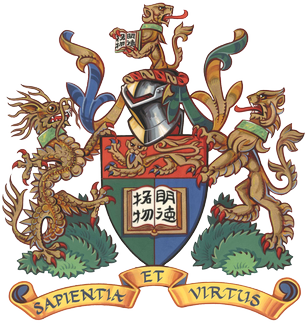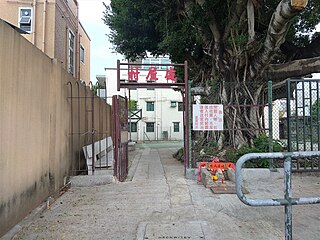
The University of Hong Kong is a public research university in Pok Fu Lam,Hong Kong Island,Hong Kong.

The Royal Hong Kong Yacht Club is a Hong Kong watersports club for sailing and rowing including paddling.

Mid-Levels is an affluent residential area on Hong Kong Island in Hong Kong. It is located between Victoria Peak and Central. Residents are predominantly more affluent Hong Kong locals and expatriate professionals.

The Hong Kong Museum of Medical Sciences was established in 1996. It is in a renovated three-story Edwardian-style building,at 2 Caine Lane at the Sheung Wan,Hong Kong Island,Hong Kong. It is also referred to as Old Pathological Institute.

Hong Kong City Hall is a building located at Edinburgh Place,Central,Hong Kong Island,Hong Kong.

Fanling Wai is a village in Fanling,North District,Hong Kong,built by the Pang (彭) Clan. It is composed of a walled village and its two extensions:Ching Wai or Chung Wai - the only walled hamlet of Fanling Wai and also the first hamlet to be built,Pak Wai,and Nam Wai.

Ping Shan is an area in the New Territories,Hong Kong. It is located west of Yuen Long Town and Shui Pin Wai,and south of Tin Shui Wai. Administratively,it is part of the Yuen Long District.

Ping Shan Heritage Trail is a heritage trail located in the Ping Shan area of Yuen Long District,in Hong Kong. The trail was inaugurated on 12 December 1993 and was the first of its kind in Hong Kong. It passes through the villages of Hang Tau Tsuen,Hang Mei Tsuen and Sheung Cheung Wai and it includes several declared monuments and graded buildings.

Sai Wan,also known as Western district,or simply Western, is an area in Hong Kong Island,Hong Kong that corresponds to Sai Ying Pun,Shek Tong Tsui,Belcher Bay and Kennedy Town. However,Some Hong Kong people consider Kennedy Town as the only part of Sai Wan. It formed part of the City of Victoria. West Point,a former cape where major government structures in Sai Wan are close to,also used to refer to Sai Wan.

Sai Ying Pun is an area in Sai Wan,on Hong Kong Island,in Hong Kong. It is administratively part of the Central and Western District.

Tao Fong Shan,officially known as To Fung Shan,is a hill with a height of 130 metres (430 ft). It is in Sha Tin,New Territories,Hong Kong. A road called To Fung Shan Road leads to the summit,where a Christian Centre can be found.

Leigh &Orange Ltd,founded in Hong Kong in 1874,is an international architectural and interior design practice. The group has a total of 550 staff and operates through its headquarters in Hong Kong with branch offices in Shanghai,Beijing,Fuzhou and Qatar.

Tin Hau temples in Hong Kong are dedicated to Tin Hau (Mazu). Over 100 temples are dedicated to Tin Hau in Hong Kong. A list of these temples can be found below.

The Tsui Sing Lau Pagoda is the only surviving ancient pagoda in Hong Kong near MTR Tin Shui Wai station and Light Rail Tin Shui Wai stop. It is part of the Ping Shan Heritage Trail and a declared monument.
Irene Chou was a Chinese artist,one of the most influential exponents of the New Ink Painting movement in Hong Kong. A leader in the New Ink Painting Movement,Chou was at the forefront of reinventing traditional ink paintings into a contemporary art form. Her contribution to ink paintings has made an impact both regionally and internationally,making way for modern ink paintings in the global art scene.

Sir Kenneth Fung Ping-fan,CBE,KStJ,LLD,DSocSc,JP was a prominent Hong Kong politician and businessman.

Shing Uk Tsuen is a village in Wang Chau,Yuen Long District,Hong Kong.

Ng Uk Tsuen or Tai Tseng Ng Uk Tsuen (大井吳屋村) is a village in Wang Chau,Yuen Long District,Hong Kong.
Fung Ka Wai is a village in Wang Chau,Yuen Long District,Hong Kong.




















